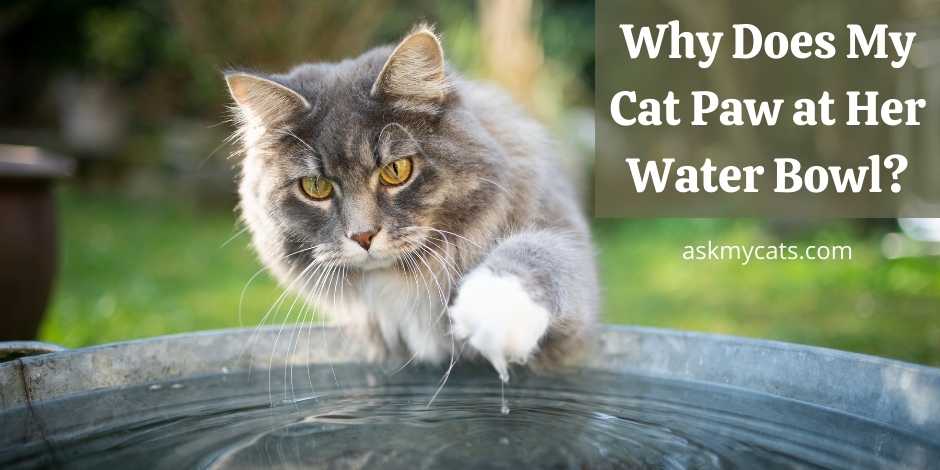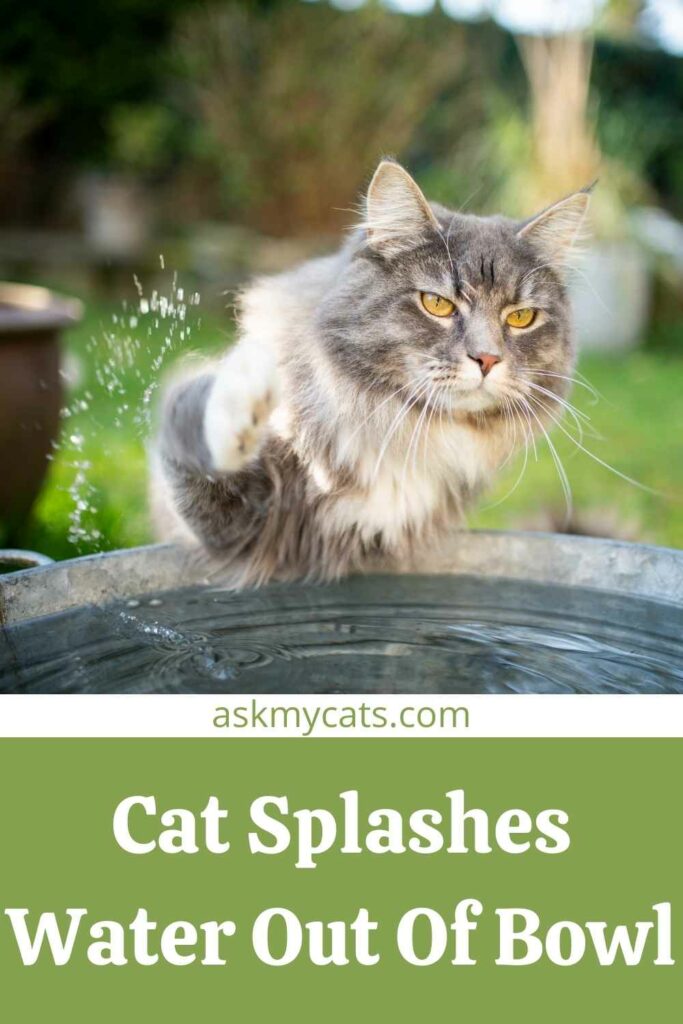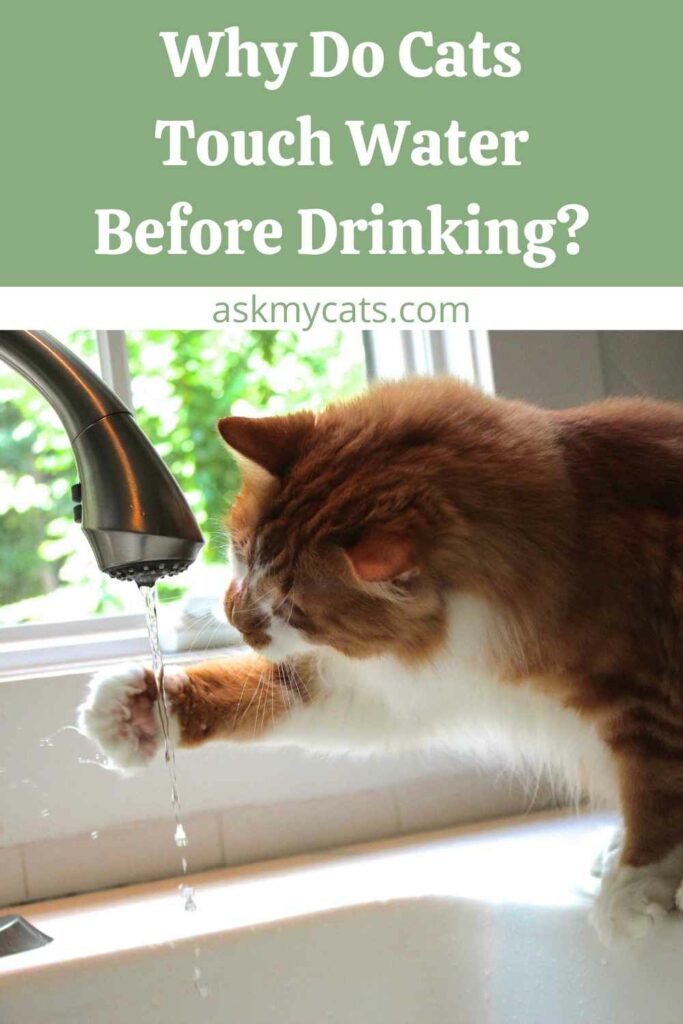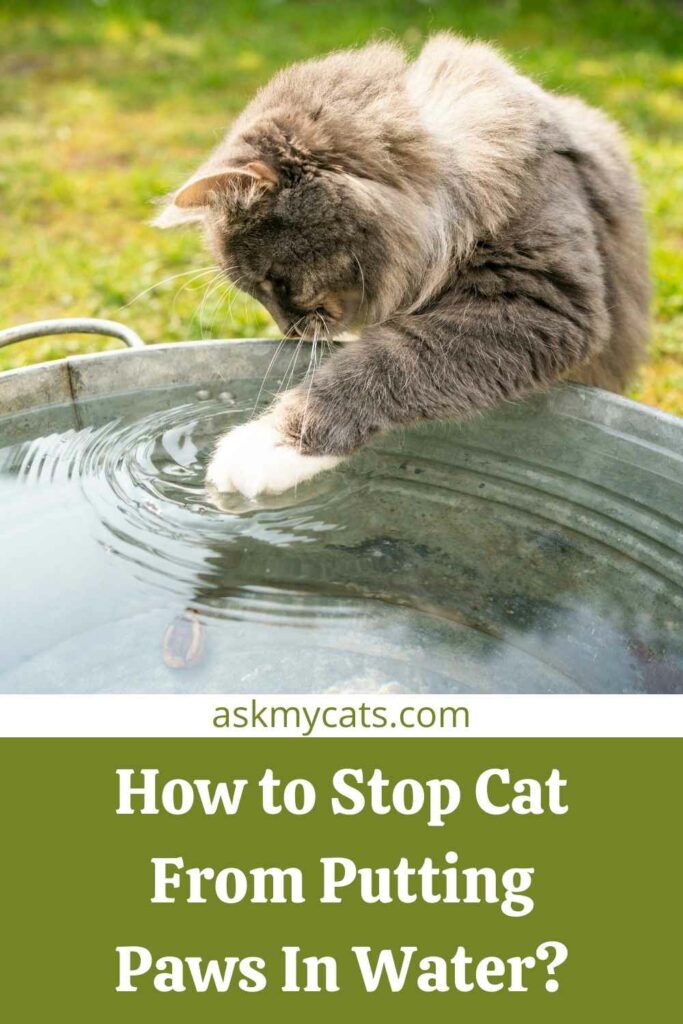Cats are usually frightened of water, so when they start tapping on their water bowl and spilling water all over the floor, it comes as a complete surprise. These lovely ladies appear to want to keep things fresh for their owners and are always surprising them!
Cats replicate the sound of rushing water by placing their paw in a water bowl. Cats are attracted to moving water because it appears to be more refreshing.
It is an easy process for many cats to drink water. They move over to the water bowl, lower their faces to the water’s surface, and sip with their tongues. When a cat is thirsty, though, a front paw becomes a useful tool.


Give Your Cat the Perfect Day
Get the Free Ebook!
Why Do Cats Splashes Water Out Of Bowl?
Cat splashes water out of the bowl because they want to play with the water.

Due to the near proximity of the water and the fact that cats can’t see what’s beneath their chin, they may want to find out where the water is by sticking their paws into it.
Cats utilize their whiskers to detect the presence of water beneath them. Cats, on the other hand, can’t fit their whiskers into a water bowl that’s too small, so they can’t do their job. They must utilize their paws in this situation.
Another reason cats dip their paws into water is to play with it. They could like watching the water move and playing with it. If you acquire a water fountain for your cats, you will find that they are in a better playing mood near water.
They frequently like to paw and play with the falling water even before eventually consuming it.
Other cats used to soak their paws in the water and then lick them; in other words, they would drink by licking their paws after they had been in the water.
They do this because they are afraid that if they let their guard down and start drinking, they will be assaulted, so they want to be always aware of what is going on around them.
Your cat’s whiskers are extremely sensitive tactile hairs. They have more nerve endings and are more deeply rooted than typical hairs.
When the cat lowers her head for a drink, the whiskers might get squished if the water bowl is too tiny or deep. A cat may learn that it’s better to merely dip a paw in the water to escape this discomfort.
Use a water bowl that is broad enough to accommodate your cat’s long whiskers to ensure whisker comfort. To prevent needing to renew the water supply as frequently, use a shallow, broad bowl that you can refill every day rather than a deep, narrow one.
Cats aren’t as unique as you may think when it comes to pawing at, playing with, or even splashing in a water dish.
Despite popular belief, some cats enjoy the water –– as long as it isn’t directed at them, as it is during a bath –– and consider water to be a fun toy. They adore the way it reflects light and splashes when they strike it.
However, most people regard water as a meal that should be given immediately rather than as a toy. Moving water is preferred by some cats to water that lies static in a dish for hours. As a result, some cats will drink aerated water straight from the faucet, a fountain, or even the toilet.
Cats that splash their water before drinking may be trying to accomplish the same result. If your cat exhibits this curiously endearing tendency, try purchasing one of the commercially available recirculating water fountains for cats. You should replace the water in her bowl at least twice a day.
Your cat may use her paw to measure the depth if you are uneven with the amount of water you put in the bowl. I’ve seen this happen with cat parents who don’t refill the dish until it’s practically dry, and then when they do, it’s completely full.
A cat may not feel safe lowering her head into an almost-empty water bowl so far that she can’t look over the edge in a multicat house where there may be some tension. It might be safer for her to use her paw so she can keep an eye out for any intruders.
To ensure that your cat has access to fresh water, clean the bowl and replenish the water on a regular basis. You’ll also be able to keep the water level in the bowl more consistent this way.
This is more about security and safety. If the bowl is against a wall and a cat would have to drink with her back to the room, she may choose to dip her paw in to avoid being too vulnerable.
Slide the water bowl out from against the wall so your cat may position herself more securely and feel more comfortable drinking in the traditional manner. It’s also a good idea to have various water stations because each cat may have a favorite drinking spot.
Also, read about why do cats slap
Why Do Cats Touch Water Before Drinking?
When cats strive to prevent the water bowl from hitting their whiskers, they dip their paws in it and then touch it.

This sensation may irritate your cat, so she should avoid it. Shallow water and food dishes are preferred by many cats. Choose a bowl with lots of room for whiskers, rather than one that is too narrow or too deep, so the whiskers don’t contact the bowl’s sides.
Some cats like to drink water that is moving. They try to replicate rushing water by putting their paw in a water basin. Moving water appears to be fresher, making it more enticing to cats.
Stagnant water has an unpleasant odor that the cats dislike. Have you ever noticed your cat consuming water from a faucet? A water fountain could be appealing to your cat.
If a cat is unsure about the water level, she dips her paw in it before drinking. When you refill the bowl on a regular basis and to a different level, this might happen.
Maintain a steady water level throughout time and while refreshing the water. Cats appreciate constancy and regularity.
Some functions, such as vision, might degrade as your cat grows older. Senior cats and cats with vision difficulties can feel the water before drinking to see how deep it is.
Then they sip by dipping their paws in water. If you have a senior cat or believe something is amiss with your cat’s eyesight, have it checked by your veterinarian.
The cat may be aiming for a quick getaway if the necessity arises by sipping by scooping the water with a paw. Changes in a cat’s habit or environment might make them feel insecure.
Keep the water bowl position consistent, establish a feeding and other interaction schedules, properly introduce new pets to the family, and make sure you have lots of water bowls of all shapes and sizes accessible for your cat to make them feel comfortable and not worried.
Dirt, litter pieces, and other detritus wash off a cat’s paw as it dips it in a water bowl. This promotes the growth of germs in the bowl.
Old Cat Pawing At Water
Old cats can get thirsty as a result of diabetes, renal disease, or thyroid problems. If they’re not feeling well, they may drink from their water bowls more frequently and make a mess by splashing or pawing at the water.
They may also seek water from other sources, such as a faucet or a toilet. Other symptoms of the disease, including lethargy, disorientation, or a change in appetite, are common in senior cats with health problems.
It’s quite unusual for a young kitten to have one of these disorders, but it’s not impossible, so call your veterinarian if you see your kitten drinking large quantities of water or spending a lot of time focusing on its water bowl.
Anxiety or stress can cause cats to behave strangely. A cat may try to get into its water bowl or put its paws in it.
Cats with separation anxiety may display aberrant behavior in order to get the attention of their owners. This can take the form of litter box troubles, like urine spraying or defecating in an inconvenient location.
Separation anxiety may cause some cats to splash in the water dish, push it away, or attempt to topple it in order to seek your attention.
Obsessive-compulsive disorders can also be exacerbated by stress. These sorts of long-term behavioral habits seldom harm kittens.
Why Do Cats Put Paws In Water?
If your cat is dipping its paws into a water dish or glass and then licking the water off, it might simply be how your cat likes to drink.
Consider it a matter of personal taste. Similar to how you may take a sip of water from the faucet with your hands, your cat may choose to drink it using its paws rather than directly from the source. This predilection might develop at a young age and has nothing to do with anything else.
Your cat’s penchant for drinking from his paws isn’t always a childhood habit. Because of how it feels on their whiskers, they may be dissatisfied with the shape of their water dish or the volume of water within it. “Whisker stress” is the term for this.
If your cat is drinking from a dish with a tiny diameter or a drinking glass designed for humans, whisker tension is more likely. While some cats dislike having their whiskers pressed against them, others are unconcerned.
If you suspect your cat dislikes drinking from a bowl, consider replacing it with a flat, shallow dish or filling up the water so their whiskers don’t brush the sides.
How to Stop Cat From Putting Paws In Water?
Reduce the quantity of water you put in your cat’s bowl and see if that helps.

Investing in a weighted water dish is the best deterrent for repeated spillers. These are usually constructed of stainless steel or ceramic, and their weight guarantees that they stay put.
As an added benefit, they tend to be quite robust and well-made, so if you need a water dish that will last, these are a perfect option.
Make sure the dish you choose is large and shallow since this will help avoid whisker fatigue.
You might also try setting up a feeding station with food and water. Splashes are contained by the high back and sides, and any extra water is filtered into a tray below. Remove the tray and dump the water once your cat has done eating.
The greatest pet water fountains are the perfect way to provide your cat with fresh, flowing water at all times. A pet water fountain is not only built to last, but it also eliminates the accessibility difficulties that come with a bowl.
Okay, so it’s not a foolproof method for preventing water leakage, but putting a tray under your cat’s water bowl can help contain any spilled water and make cleanup a breeze.
You’d be shocked how quickly dust, food particles, hair, and other debris may pollute the water in your cat’s dish. Spilling water might be an indication that your cat doesn’t like the taste of their water.
Unless you have a pet water fountain that takes care of this for you, you’ll need to change your pet’s water at least once a day.
Frequently Asked Questions
Why do cats paw the floor before drinking water?
Your kitten or cat may paw, scratch, or knead the floor before or after eating or drinking as if digging or burying something. In reality, your pet is displaying an impulse that is shared by even the largest cats, and it is a very good indicator that it is at ease in your home.
Why do cats swat their water bowls?
In puddles of stagnant water, dangerous germs are more prone to thrive. Slapping at the water dish allows cats to move their water around a little, making them feel more comfortable about drinking it.
Why do cats play in their water dish?
Kittens that play with water are probably doing so to learn about their surroundings. Some cats enjoy being near water. Finally, some cats prefer to drink fresh water rather than stagnant water in their bowls. They might be imitating the rippling effect of freshwater by playing with water.
Final Words
This happens frequently because cats can’t perceive the water levels, and having the water ripple helps them notice them.
They might also be suffering from whisker fatigue, have health problems or worry, or simply enjoy running water. Perhaps they simply enjoy playing with their water bowl.
Leave your questions in the comments section below.
